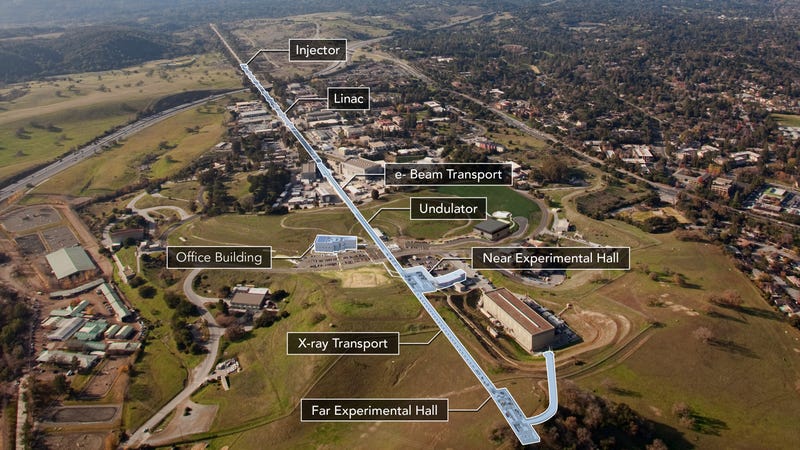Nothing can travel faster than light, or 299,792,458 meters per second. But a certain group of particles acts as if it can, a team of physicists recently concluded, potentially paving the way for a powerful light source that could reveal new kinds of science.
When electrons are excited and pushed around, they produce light of various energies that can be used to study phenomena far beyond the limits of the naked eye or typical microscopes. Scientists have learned how to generate and corral electrons in machines, to get the particles to produce light of high energies. These light sources—from synchrotrons and cyclotrons to linear accelerators—allow scientists to see incredibly tiny things, like the structure of a molecule. The insights gleaned from this technology have enabled the development of new drugs, the creation of better computer chips, and non-destructive research into fossils. The waves emitted by electrons literally shed light on what would otherwise be invisible.
But these light sources are not common. They’re expensive to build, require large amounts of land, and can be booked up by scientists months in advance. Now, a team of physicists posit that quasiparticles—groups of electrons that behave as if they were one particle—can be used as light sources in smaller lab and industry settings, making it easier for scientists to make discoveries wherever they are. The team’s research describing their findings is published in Nature Photonics.
“No individual particles are moving faster than the speed of light, but features in the collection of particles can, and do,” said John Palastro, a physicist at the Laboratory for Laser Energetics at the University of Rochester and co-author of the new study, in a video call with Gizmodo. “This does not violate any rules or laws of physics.”
“I think relaxing those requirements on the electron beam and getting away from this idea that every electron has to be moving in unison to produce this very coherent radiation, really democratizes these sources—it makes them more widely accessible,” Palastro added.
In their paper, the team explores the possibility of making plasma accelerator-based light sources as bright as larger free electron lasers by making their light more coherent, vis-a-vis quasiparticles. The team ran simulations of quasiparticles’ properties in a plasma using supercomputers made available by the European High Performance Computing Joint Undertaking (EuroHPC JU), according to a University of Rochester release.
Large linear accelerators are some of the most powerful light sources on Earth. Consider the $US1 billion upgrade to SLAC National Accelerator Laboratory’s Linac Coherent Light Source—simply dubbed LCLS-II—which achieved first light last month. LCLS-II can generate one million X-ray pulses per second, up from the original LCLS’ minuscule 120 pulses per second. The new X-ray pulses are 10,000 times brighter than those produced by LCLS, paving the way for scientists to peer at previously unseeable phenomena, from molecules in plant cells to how materials change phase. All those X-rays are produced by intentionally wobbling (or ‘undulating’) groups of fast-moving electrons, using large magnets. You can read a full breakdown on how linear accelerators like LCLS-II work here.

In a linear accelerator, “every electron is doing the same thing as the collective thing,” said Bernardo Malaca, a physicist at the Instituto Superior Técnico in Portugal and the study’s lead author, in a video call with Gizmodo. “There is no electron that’s undulating in our case, but we’re still making an undulator-like spectrum.”
The researchers liken quasiparticles to the Mexican wave, a popular collective behaviour in which sports fans stand up and sit down in sequence. A stadium full of people can give the illusion of a wave rippling around the venue, though no one person is moving laterally.
“One is clearly able to see that the wave could in principle travel faster than any human could, provided the audience collaborates. Quasiparticles are very similar, but the dynamics can be more extreme,” said co-author Jorge Vieira, also a physicist at the Instituto Superior Técnico, in an email to Gizmodo. “For example, single particles cannot travel faster than the speed of light, but quasiparticles can travel at any velocity, including superluminal.”
“Because quasiparticles are a result of a collective behaviour, there are no limits for its acceleration,” Vieira added. “In principle, this acceleration could be as strong as in the vicinity of a black-hole, for example.”
To be clear: the electrons in the bunch composing the quasiparticle are not moving faster than light. But the quasiparticle can effectively travel faster than light, the researchers say, if the wavelengths involved are larger than the quasiparticle itself.
The difference between what is perceptually happening and actually happening regarding traveling faster than light is an “unneeded distinction,” Malaca said. “There are actual things that travel faster than light, which are not individual particles, but are waves or current profiles. Those travel faster than light and can produce real faster-than-light-ish effects. So you measure things that you only associate with superluminal particles.”
The group found that the electrons’ collective quality doesn’t have to be as pristine as the beams produced by large facilities, and could practically be implemented in more “table-top” settings, Palastro said. In other words, scientists could run experiments using very bright light sources on-site, instead of having to wait for an opening at an in-demand linear accelerator.
